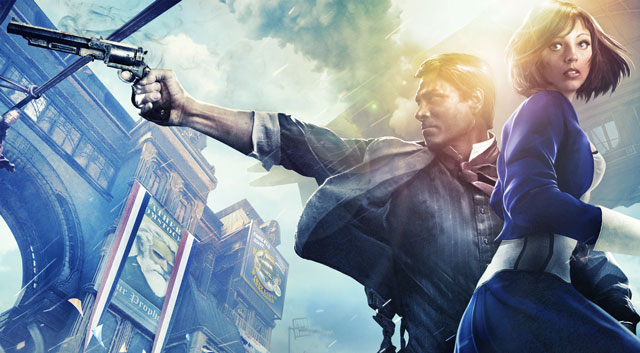
Bathed in celestial light, and with the wholesome aroma of carnival popcorn in its air, BioShock Infinite’s airborne city of Columbia is as far from the water-sodden Objectivist dystopia of BioShock in atmosphere as it is in geography. But under its turn-of-the-century fairground Americana, Columbia churns with currents as dark as those that sank BioShock’s Rapture.
BioShock Infinite, from the mind of BioShock creative director Ken Levine (he wasn’t closely involved with BioShock 2), is a first-person shooter (FPS) with a philosophical bent. Like its predecessor, it is a meditation on the dangers of utopianism, this time embodied in the American exceptionalism and religious mania of one Zachary Hale Comstock and his crazy flock. Into Comstock’s floating paradise in the clouds sneaks a serpent in the form of the player character Booker deWitt.
DeWitt, a debt-ridden former military man and Pinkerton agent, has been sent to find a young woman called Elizabeth and bring her back to New York. But as he explores Columbia in search of Elizabeth, DeWitt uncovers a world of greed, racism, slavery and militarism lurking behind the hotdog stands and barber shop quartets.
Here, there’s a war underway between a resistance movement of the downtrodden called the Vox Populi and Comstock’s ultranationalist, white supremacist followers. It’s a brilliantly realised world, brought to life through a striking art style that recalls World War I propaganda posters and early 20th century advertising.
HOW IT SCORES
Graphics: 9/10
BioShock Infinite is not as technically impressive as the likes of Crysis 3 or Tomb Raider, but exceptional art design makes it one of the best looking games of the year.
Sound: 9/10
The voice acting is uniformly strong; the ambient score and contextual music are wonderful, too.
Gameplay: 8/10
Though not as rich in emergent gameplay as BioShock, Infinite melds gameplay and narrative into a beautifully cohesive package.
Value: 9/10
Sure, the campaign will keep you busy for only 10-12 hours, but they’re some of the best hours you’ll spend with a game this year.
Overall: 8/10
Bioshock Infinite is a game of breathtaking ambition that wraps its arms around hefty philosophical themes. It also happens to be a deeply satisfying FPS.
From dramatic cloudy views of the city through to its propaganda posters, signage and snatches of conversation overhead from non-player characters, every detail is a brick in the city that makes Columbia feel more real and tangible. The storytelling and characterisation is also done with slightly subtler shading than it was in BioShock.
Refreshingly, most of the narration takes place through details in the game world rather than through endless expository cut scenes. Though the narrative has its failings, I was riveted to the game until its thought-provoking ending because I wanted to know more about Booker’s past, who Elizabeth is and why she is so important, and what happened to Columbia.
Perhaps you’ll play the game as DeWitt — who, unlike the player character in BioShock, speaks — but Elizabeth is the character that you’ll remember. She’s warm, has an engaging presence and is so full of life that it’s easy to forget that she exists mostly as a gameplay mechanic and a mouthpiece for exposition.
When it comes to its gameplay, BioShock Infinite is a more-than-capable FPS with a few interesting twists. Much like Bioshock 1, Infinite’s combat is based on a mix of bodily superpowers — this time called “vigors” rather “plasmids” – and the usual FPS mix of machine guns, shotguns, rifles and RPGs. Earlier in the game, the shooting feels a little loose and uninspired, but the action livens up as you move deeper into BioShock Infinite’s world and discover new weapons and powers as well as upgrade the ones you discovered earlier in the game.
BioShock Infinite: creating Elizabeth (via YouTube):
Things also get more interesting once Elizabeth is at your side. She not only scavenges ammo and health packs for you in combat, but can summon machine-gun turrets, automatons and other allies to help out through “tears” in the fabric of reality. Even so, BioShock Infinite feels like it offers a narrower set of emergent gameplay possibilities than did BioShock’s combat sandboxes.
Not only does BioShock Infinite offer a slightly smaller set of powers to experiment with, many of them also feel more similar in effect than did the options the earlier game offered. And where BioShock offered multiple ammo types for most weapons, each gun fires only one kind of projectile in Infinite.
The enemies you will face are formidable, especially when tougher automatons come into play later in the game, but none of them are as fearsome and iconic as BioShock’s Big Daddies. The artificial intelligence is cunning enough to use tactics such as flanking and taking cover, and puts up enough of a fight to be entertaining.
The campaign is all there is to BioShock Infinite – no tacked-on multiplayer, no pointless combat arenas. On normal difficulty — which I found a little too easy — a playthrough took me about 12 hours, with thorough exploration of most of the game’s levels. Given the quality of the single-player experience, there is no reason to feel cheated. When you complete the game, it unlocks an unforgiving 1999 mode that harkens back to the challenge System Shock 1 and 2 offered back in the day.
Though its gameplay feels like a bit of a step back from its predecessor, BioShock Infinite’s narrative and world-building represents a big leap over BioShock. All of its elements, from the graphics and sound to the AI and gameplay, congeal into an unforgettable experience. You might not remember who you killed when you visited Columbia, or how, but the girl at your side and the journey you went on together will stay with you long after you finish the game. — (c) 2013 NewsCentral Media
- Reviewed on PC. Also available on PlayStation 3 and Xbox 360.

